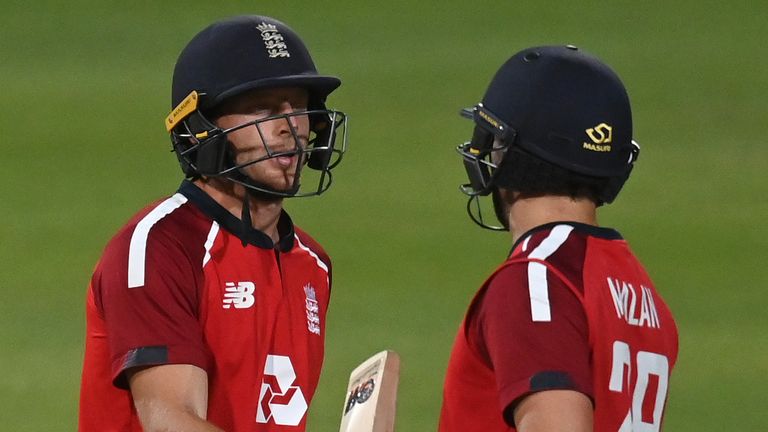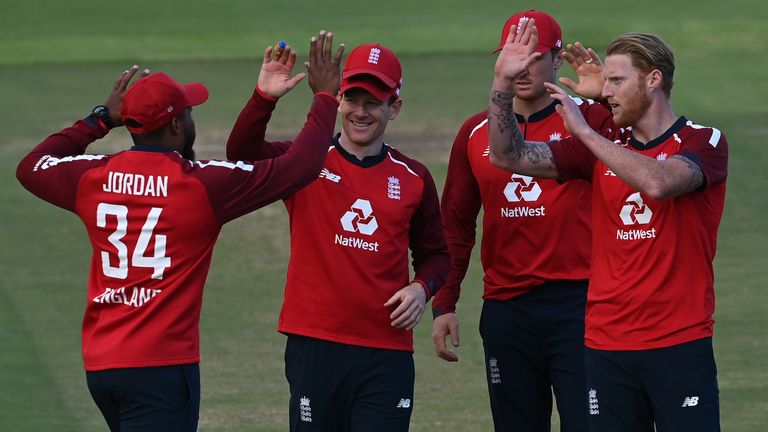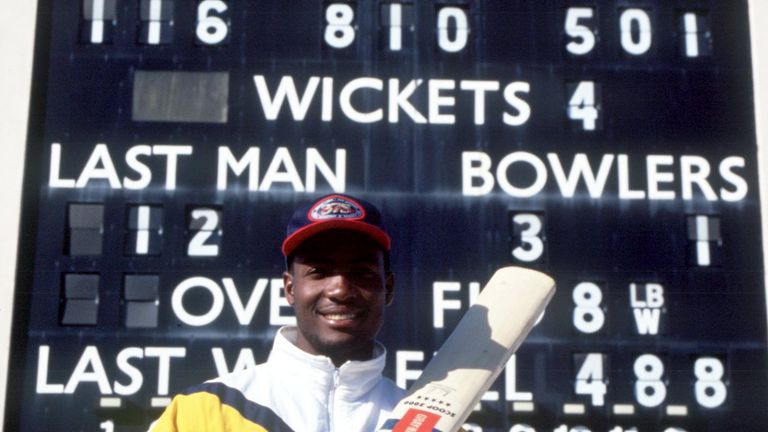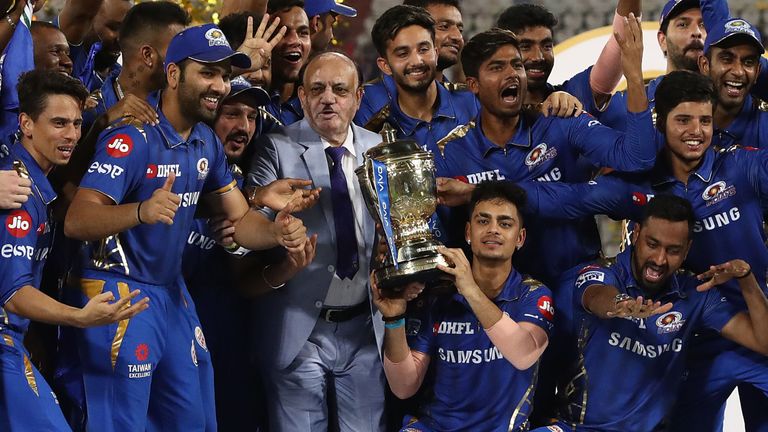England's coded messages: Is cricket in the midst of Moneyball-style revolution?
While similarly stat-heavy sports such as baseball have undergone analytics-led revolutions, cricket has previously been averse to change; Sky Sports statistician Benedict Bermange looks at how and why that might finally be changing
Tuesday 8 December 2020 11:53, UK
Spare a thought for Dawid Malan.
Not only did he lead England to a series clean sweep in the third Twenty20 international at Cape Town, but he achieved the highest points tally ever by a batsman in the ICC Twenty20 International Batting Rankings.
But whereas the press might have been lauding him for his twin achievements, it was the coded messages sent from the dressing room in the latter stages of South Africa's innings which took most of the headlines.
- What's with England's secret signals?
- Eoin Morgan: England will continue using coded messages
- 'Big Bash innovations complicate cricket'
Not that they seemed to help England at the time, as they leaked 84 runs from their final five overs as Rassie van der Dussen and Faf du Plessis made hay. But it was the ethical notion of whether sending information to the middle was within the spirit of the game.
Make no mistake - England had played by the rules as they had run their plan past the ICC match referee and he had no objection to the system.
Every so often statisticians - so keen to lurk in the shadows - are thrust to the forefront of the world game. Think back to 1992 and the infamous World Cup semi-final at Sydney. Out of South Africa's target of 22 runs from one delivery, two statisticians became household names with a new system for dealing with rain-interrupted cricket matches - Frank Duckworth and Tony Lewis.
We are now up to the fourth iteration of the program which continues to evolve as the game does.
In the 1999 World Cup, South African coach Bob Woolmer - very much at the forefront of innovative ideas - borrowed an idea after having watched American sports in which it had become common practice for players to wear earpieces to hear instructions from their coaches.
As with England at Cape Town, Woolmer checked that his idea did not contravene either the Laws of Cricket or the Tournament Playing Regulations, and pioneered the system in South Africa's opening game against India at Hove.
However, the Indian opening batsmen spotted what was going on, and brought it to the attention of the umpires. They in turn contacted the match referee, who contacted the ICC who said while the earpieces did not contravene any playing conditions, they were deemed unfair and so were removed from the field of play. The practice was banned soon afterwards and so players and coaches needed to find different ways to communicate.
One of the great things about cricket's numbers is that the figures themselves become etched in the fabric of the long historical narrative of the game and can be instantly recalled by fans of the game. Every cricket fan knows what 99.94 means. And 501. For many decades they have known what 10‐10 refers to.
They do not need any embellishing - the number alone is enough to allow the fan to identify the accomplishment, no matter how long ago the feat was performed. Most people would find it difficult to think of more than a few such numbers in any other sport, whereas in cricket it is not difficult to think of quite a few with special resonance.
What helps is how well cricket records have been kept. We can look back at a game in the 1870s and discover how many wickets Alfred Show took, and if he scored any runs or took any catches. The scorecard of a match has looked fairly unchanged for 150 years.
It was a former biologist by the name of FC Lane who was an early champion of looking 'beyond the box score'. Back in the 1910s he authored a number of baseball-related articles with such intriguing titles as "Where the Baseball Records fail the tell the Truth" and "A Brand New System of Batting Averages" which examined aspects of the game that had never been looked at before.
He tried to account for the different sizes of the stadia or the relative merits of a single, double, triple or home run.
Analytics has been slowly creeping into the field of sports ever since the release of the book - and then film - 'Moneyball' in which the Oakland A's General Manager Bill Beane felt that conventional wisdom from his scouts was subjective and flawed and did not stand up to modern empirical statistical data.
Indeed, it was in baseball where one man started to push the analysis of statistics to a new level. Allan Roth was the first to be employed full time by a major league team when Brooklyn Dodgers president Branch Rickey appointed him in time for the 1947 season.
He became the first man lucky enough to get to test his theories on the field of play. Each of the 40-odd thousand pitches in a Dodgers season would call for up to 12 different notations, all so that he could try to discover any tiny edge for the team to exploit.
His analysis enabled the team to take advantage of any potential match-ups on the field of play which appeared advantageous, in the same way England had hoped to over this past week. Roth estimated that after each game, he would spend a further five hours updating all the breakdowns for both the Dodgers and their opponents.
By the end of the 1960s many major corporations had some sort of mainframe computer which offered great possibilities to those select few people who knew how to actually use them, such as two Seattle youngsters by the names of Paul Allen and Bill Gates!
Two brothers - Harlan and Eldon Mills - used punch cards to program a computer in order to evaluate players by measuring their impact on the probability of winning a game. Their publication entitled "Player Win Averages" attempted to quantify this, and inspired all future attempts across a multitude of sports to try to discover which players perform best when the game is on the line.
Baseball analytics had its epiphany in part because writer Bill James and others realised that baseball was only barely a team sport, and really could be reduced to a discrete sequence of outcomes that involved singular players competing in sequences of one-on-one scenarios.
Cricket is the ultimate one-on-one sport masquerading as a team sport: not including run outs, rarely more than three players are involved in any game-event, which is another way of saying that any given time, at least 77 per cent of the players on the field are doing literally nothing to impact play.
But why didn't cricket see Moneyball-type analysis take off at the start? Advanced statistics in American sports were traditionally used for two related but distinct purposes: to evaluate talent, and to employ better strategies.
In international cricket there is no movement of players because of the restrictions of nationality and birth, and in domestic cricket there has always been little money and no thriving transfer market.
The tactics and strategy element certainly comes into it but cricket people have also traditionally been averse to trying new ideas. They have been seen as slow to change and judged cricket by personal observation, by considered opinion and by accepted, long-established statistical methods such as simple batting and bowling averages.
In 2008, the IPL solved those problems. It was awash with money and player movement has not been hindered. The auction, where players are bought and sold according to perceived market value, is similar to the draft system in baseball that allowed Billy Beane and his Oakland As to seek out market inefficiencies with his pure data.
In the first edition, Rajasthan, at $67m the cheapest franchise of the lot, won the title, although it must be said in no small part due to the inspired captaincy of Shane Warne. They also uncovered a star in Sohail Tanvir, who topped the wicket-taking charts having signed for just $100,000.
The following year, frustrated with their bottom-of-the-table finish in the inaugural IPL, the Deccan Chargers, under Darren Lehmann and forward-thinking CEO Tim Wright, employed a statistician to try to improve their performance and given them that "extra 1 per cent" that is so often mentioned. The result? They won the title.
Now, all international and domestic teams around the world employ a team of statisticians trying to gain that crucial edge. Today's powerful computers give clubs and analysts the ability to use data in ways undreamed of just a few decades ago, and it was just this kind of analysis with which the England dressing room were hoping to impart to Eoin Morgan on the field.
In the end it did not matter, as England chased down their target of 192 easily, but the sight of the flashcards on the balcony may well have been the lasting impression from this particular victory.











